New Entrants and Young Farmers Start-Up Grant Schemes: evaluation
Evaluation of the New Entrants and Young Farmers Start-Up Grants, which discusses the challenge of generational renewal in the farming sector and considers the extent to which the grants contributed to our aims to encourage new, younger entrants to the industry.
3 Survey Research: Views of Grant Recipients
3.1 Survey Methods
To learn more about the experience of new entrant farmers, a web based survey was sent to recipients of the two start-up grants. The survey was online between October 2020 and January 2021. There were 67 responses received to the survey. In a context of 254 awards overall, this represents 26% of the total population of grant recipients. The number of respondents was approximately evenly distributed between the New Entrants Start-Up Grant and Young Farmers Start- Up Grant, with 51% and 49% respondents each respectively. Therefore, of 49 successful new entrants awards, 34 responded to the survey, compared to 33 young farmers out of the 205 total. This equates to 69% and 16% response rates respectively. From this perspective, recipients of the Young Farmer Start-up Grant are comparatively under-represented in this survey. The survey sample did not include those whose grant applications were unsuccessful.
3.2 Participant Demographics
Looking at the respondents to the sample, 67% were male, compared to 31% female (and 2% who preferred not to say). The age distribution can be seen in Figure 1. The age was, unsurprisingly, younger than the average of age of the farming population more broadly. Overall, 82% of the respondents were aged between 30 and 49 at the time of completing the survey.
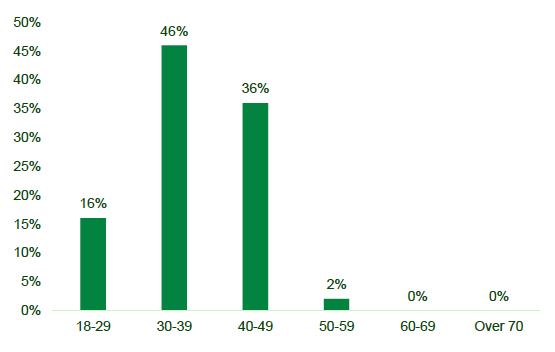
Looking at when respondents had been awarded their grants, 46% had been awarded their grants in 2016, compared to 25% in 2017 and 22% in 2018, with 6% reporting 'other'.
Slightly over a quarter of the farms in the sample were located in the Highland local authority. The geographical distribution of the sample can be seen in Figure 2. Aberdeenshire is the next most common, followed by the Orkney Islands. It is worth observing that these areas are typically characterised as 'less favoured areas', which indicates that the geography of the area is challenging for farming (and, in turn, receiving an additional subsidy on this basis).
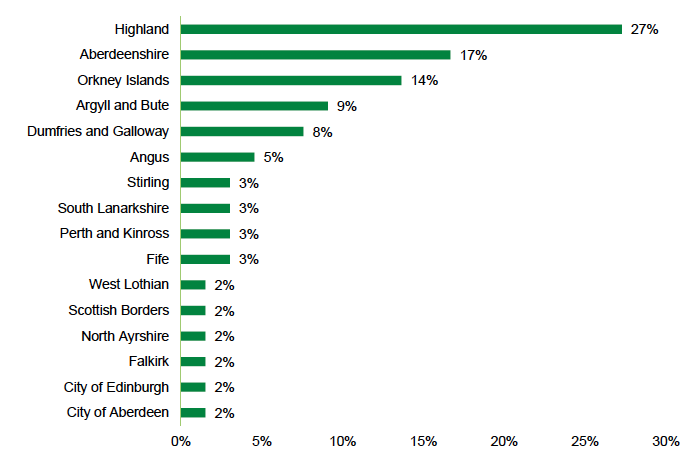
3.3 Participant Education Levels
In terms of the educational background of participants, 49% reported having Degrees or Professional Qualifications. According to the 2019 Scottish Household Survey, 32% of Scottish people held a degree or professional qualification, making our sample more educated than the population at large (see Figure 3).
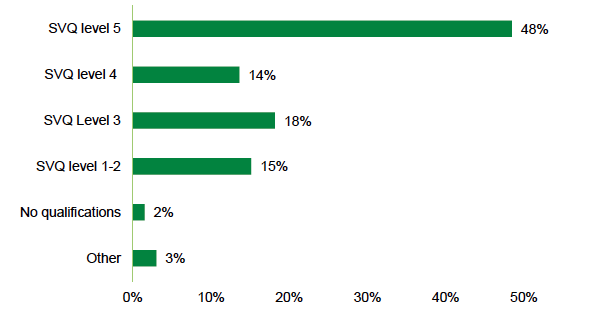
We also asked whether the sample had received any specific qualifications concerned with agriculture. Of the 66 who responded, 30% had no specific agricultural qualifications. The most common qualification was in 'Agriculture and Crofting' – held by 50% of the sample – followed by qualifications in 'Land based engineering' and 'Environmental science and conservation', at 6% each. Finally, 5% reported qualifications in animal care and 3% reported qualifications in estate management.
3.4 Characterising the Sample: Background and Aspirations
In terms of the backgrounds of the sample, 54% of the sample said 'Yes' to the question 'did you grow up on a farm?', and 46% said no. A further, 72% had previously worked on a farm – with 8% previously managing a farm – while 21% had no prior experience. Based on cross-tabulations, approximately 18% of respondents lack any experience of either growing up on a farm or previously managing it. This supports the view found elsewhere in the literature that farming has a 'family' or 'generational' element to it.
We asked what the respondents' primary goals in pursuing a farming career were. This is displayed in Figure 4. Because participants could tick multiple options, the percentages do not sum to 100%.
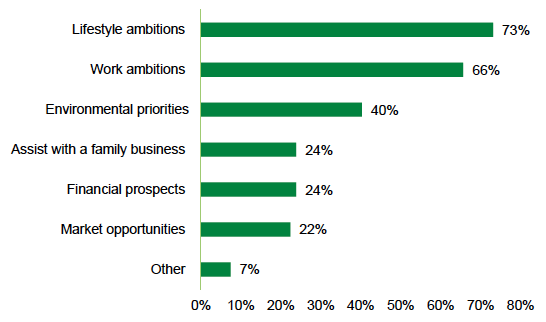
As this demonstrates, the most popular goals were concerned with ambitions in terms of lifestyle and work. By comparison, while almost one in four were seeking to assist a family business, financial and market opportunities were only cited by a minority of participants. As this indicates, even among market entrants, the prospects associated with farming are not widely regarded as positive.
3.5 Access to Land
Given the observations above, access to land is a pressing challenge facing new entrants to farming. We asked the sample about their ownership situation. This indicated that 42% of the sample rented all of their land, with 23% renting at least some of their land. We also observed that, for 39% of the sample, they were farming land that had previously been owned by their family. Cross tabulations did not show a strong relationship between family ownership and current land ownership, however, but it is of interest that succession still appears to play an important role in supporting new entrants in this sample. Overall, the majority - 65% - of the sample did not own their farm outright.
3.6 Farming Enterprises
We asked participants to list their main farming enterprises, which is displayed in Figure 5. Please note that the question anticipated that participants would have more than one 'main' enterprise on their farm, so participants were able to tick multiple boxes in their response. As a result, the percentages do not sum to 100%.
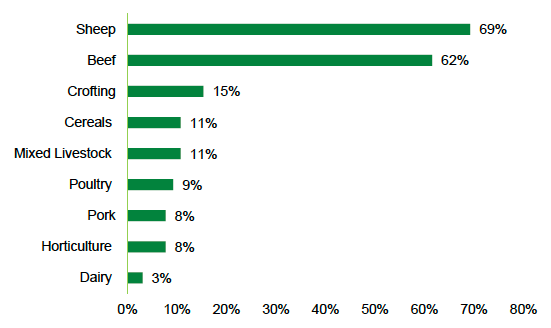
As this demonstrates, the sample's enterprises were primarily focused on livestock, with sheep being the most common and beef the second most common. This is worth noting owing to the fact that, as observed in the Total Income from Farming 2017-19 report published in 2020[8], Less Favoured Area (LFA) sheep and beef farming, and lowlands beef and sheep farming frequently struggle with profitability, given the range of challenges these enterprises face.
Organic certification was low, with only 3% of the sample being currently in the process of becoming certified and none currently certified in this way. This may reflect the time it takes to achieve certification. Diversification was also observed in 25% of the sample, with renewable energy generation, 'other', accommodation and farm shops mentioned. However, this is actually substantially lower than the figure identified in the Total Income from Farming 2019-2019 report, which found that over half of farms had diversified.[9]
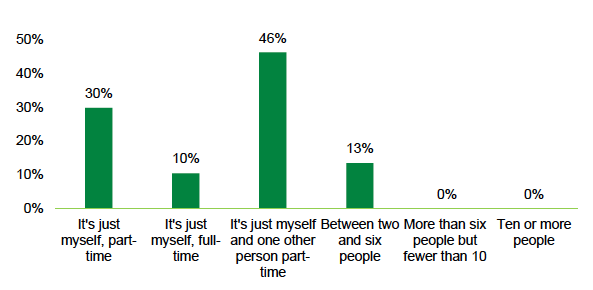
As this indicates, 86% of the farms either employed no one or employed one person on a part-time basis.
In term of farm size, the majority of the farms in the sample were under 50 hectares, but only narrowly, with 11-20 hectares as the second most common size-band.
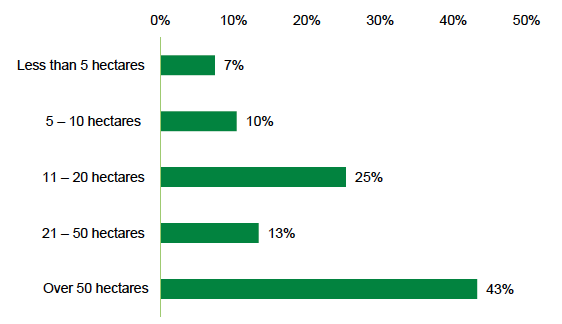
3.7 Policy Support and Challenges
Slightly over one quarter of the respondents – 27% - disagreed that they found it easy to access the support and information they needed (6% of these strongly disagreed). Of those who agreed that it was easy to obtain this, 16% strongly agreed, while 42% somewhat agreed. When asked whether they found it easy to access training and information to improve practical farming abilities, only 51% of the sample agreed this was the case. 31% were neutral, with a further 18% disagreeing.
In terms of using the Farm Advisory Service, 37% of respondents reported using none of the available services, while 63% who used at least one. Of these, attending events was the most common activity, undertaken by 46% of the sample as a whole.
In terms of future prospects, the majority of participants – 67% - said it was 'very likely' they would be managing their farm business five years from now. A further 13% were 'somewhat likely', but almost 19% were either 'neutral' (12%), 'somewhat unlikely' (3%) or 'very unlikely' (5%). When asked about what future support would be valuable, the results are displayed in Figure 8:
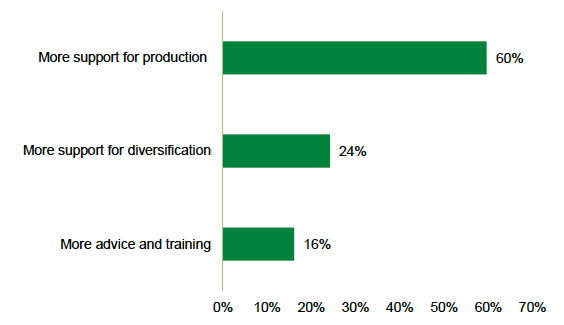
As this indicates, while there is support for additional work around advice and diversification, it is the perceived challenges of production that are most pertinent here. This is further reflected in the responses to our question regarding the biggest challenges facing the sample (see Figure 9).
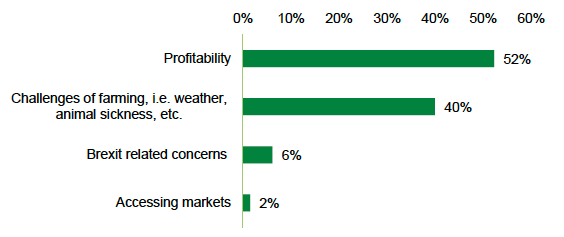
Taken with the above emphasis on profitability as the key challenge facing the sample and the earlier observations about the challenges of profitability in livestock operations, we can hypothesise that the challenges of profitably producing food are highly pertinent here. This is further reflected in response to the ranking question on farming priorities (see Figures 10 and 11).
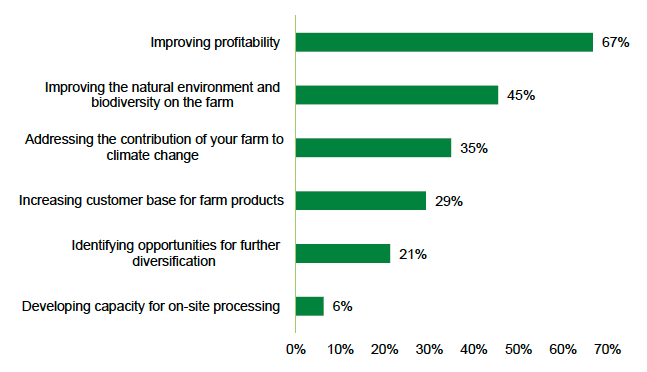
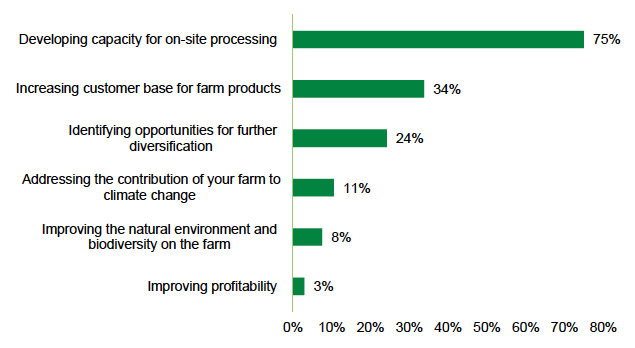
3.8 Financial Viability of Farms
In terms of the viability of the farms, 93% reported receiving basic payments, and 70% received Less Favoured Area Support Scheme (LFASS) payments. While basic payments are common within the sector, approximately 11, 000 farmers receive LFASS payments. In terms of the income from farming, however, 51% of the farms made an annual average income that was lower than £10,000, with a further 24% making less than £20,000. This indicates that, for the majority, the farming is extremely financially challenging.
As above, profitability is a critical challenge. In our sample, 36% of farms did not make a profit, even including subsidy - 9% did not know - and, excluding subsidies, 75% of farms did not make a profit. However, it should be noted that 57% of the sample reported that they expected the farm to become more profitable. It may be the case that ample time has not passed to allow the farm businesses to become profitable.
To compare these figures to the current figures, the Farm Business Income 2017-18 report indicates that over 60 per cent of farms made a loss without subsidies (as compared to 75% in this sample). As below, 75% reported making less than £20, 000 in income.
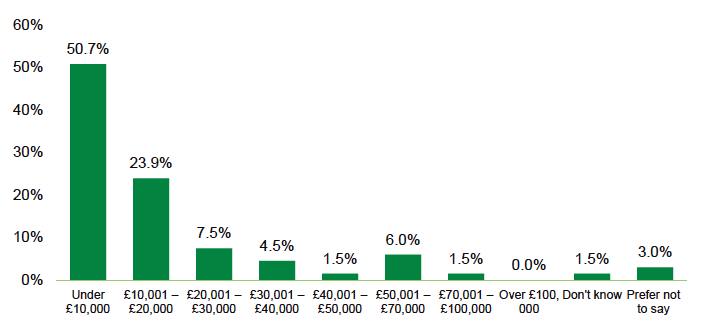
As this comparison shows, the sample incomes were lower than those reported here. However, they are comparable, and indicate broader challenges facing farm incomes in the sector as a whole. It is not at this stage possible to straightforwardly discern why this is the case – differential subsidy entitlements owing to different farm sizes may play a role – but it is notable that the experience of New Entrants may be more challenging than the overall population, but it is not dramatically distinct from it.
Contact
Email: socialresearch@gov.scot
There is a problem
Thanks for your feedback